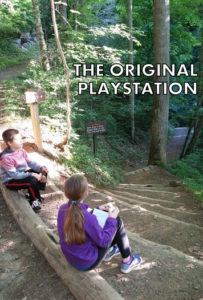That phrase was coined by author Richard Louv in his book “Last Child in the Woods” to describe the phenomena of children and youth becoming disconnected from nature. Adults can certainly suffer from nature deficit disorder, but chances are, most adults spent more time outside as children than our kids do today. Research is linking nature deficit with some disturbing child outcomes, such as increases in obesity, attention disorders and depression as well as diminished use of one’s senses.
Some of the reasons for this disconnect with nature in recent decades include urbanization and disappearing green spaces, spending more time indoors, and increased use of technology and electronic communications. These trends contribute to a devaluing of independent play and what health experts are calling the “epidemic of inactivity.” The time kids spend outdoors is increasingly spent in structured play or organized sports, instead of ‘playing in nature.’ Unstructured play in nature allows for developing problem-solving, creativity and emotional development, according Dr. Stephen Kellert of Yale University. In his book “Building for Life: Designing and Understanding Human-Nature Connection,” Kellert urges community leaders and urban designers to consider green space and creating opportunities for children to have positive interactions with nature on a daily basis.
 We can reverse this nature deficit disorder for ourselves and our children. Connecting with nature can have physical, mental and social health benefits for adults and children alike. Research results found that spending time in nature can help prevent cancer cell development, strengthen the immune system and aid in stress reduction. The Children and Nature Network is dedicated to connecting children, families and communities to nature through innovative ideas, evidence-based resources, and collaborative efforts. The Children and Nature Network’s Toolkits offer these ideas to get your family connected:
We can reverse this nature deficit disorder for ourselves and our children. Connecting with nature can have physical, mental and social health benefits for adults and children alike. Research results found that spending time in nature can help prevent cancer cell development, strengthen the immune system and aid in stress reduction. The Children and Nature Network is dedicated to connecting children, families and communities to nature through innovative ideas, evidence-based resources, and collaborative efforts. The Children and Nature Network’s Toolkits offer these ideas to get your family connected:
Nature is everywhere. You can find nature by planting seeds in a pot on the front porch or sketching a tree as well as by venturing into a wild preserve.
Be prepared. In order to get the most from your time outdoors, bring along snacks, water, sunscreen, and even a change of clothes in case your kids get wet or cold.
Embrace the elements. Dress for the weather, stomp in a puddle, enjoy a rainy or snowy walk in the park.
Model curiosity. If you see plants or animals or holes or nests you can’t identify, show your curiosity. Kids have a natural sense of wonder and this can lead to some awesome discoveries. You can look things up together when you get home.
Bring friends. Your family can bond in the company of other families; in fact, you might have even more fun!
Create stories. At the end of the day, have each family member talk about their favorite part of the time spent outdoors. These will become part of your family lore. You can revisit those places and support the wonderful connections you’ve built together outdoors in nature.
Make it a goal to spend an hour outside each week, connecting with nature and with others. See this PBS article for more ideas on how to help your kids get plugged into nature. You can also check out your local parks for nature education programs. Richard Louv offers a Resource Guide full of ideas for connecting with nature.
Get outside. Get connected. Get into nature.

